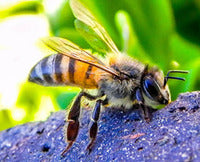If you and your dog have had the unfortunate experience of being under attack by bees or wasps, you already know how terrifying it can be. Long after the physical effects of the bee stings are under control, the emotional impact can still take its toll. Knowing what to do when attacked, or better yet knowing how to avoid an attack, will go a long way in helping to prevent a bee-wildering experience!
When Bees Are Present or Attacking
Unless your dog has already been stung, he may not be aware of the danger in a bee or wasp encounter. If you think there is a nest in the area, see some bees swarming over a dead log up ahead or feel a few of them dive-bombing you, leave immediately with your dog and avoid loud noises when retreating.
Don’t stop to swat at them – it will only aggravate them more. If they are after you, just run like the wind. There is nothing more you can do at that point other than protect your face and your dog’s face if you’re holding him. Running into the wind may help disturb their flight, but don’t stop until you are sure they’ve retreated. At that point, if you’re around a lake, take him into the water and cover him as deeply as possible to drown any bees hiding in his coat.
The Signs of Bee Stings
If you are with your dog when bees attack, you’ll probably notice him jumping up and crying out, rubbing at his eyes or mouth, or biting at the sting site. If you didn’t see him get stung, you may notice swelling or see him scratching or chewing where he got stung. Bees and wasps usually will sting a dog in a less hairy spot like the underbelly or nose, but they can also sting in hairier areas. If he was snapping at a bee, you may find a sting inside his mouth or in the ear area.
If you think your dog has multiple bee stings, you may need to go see your veterinarian. The severity of the situation depends largely on the degree of swelling and the possibility of being allergic to bee stings. That is a life-threatening emergency. If severe, these signs will appear in the first 5-30 minutes:
- Excessive drooling or salivation
- Vomiting or diarrhea
- Difficulty breathing
- Trembling
- Collapsing or fainting
- Pale gums
- Hives
- Mental change or abnormal behavior
Treatment for Bee Stings
In extreme cases, your veterinarian may give your dog Benadryl and/or a strong anti-inflammatory drug. If you learn that your dog is allergic to bee or wasp stings, you may want to carry an EpiPen with you. This pen contains an injectable epinephrine to counteract the allergic reaction. Again, seek your vet’s advice on whether this is a good countermeasure and also the dose to use for your dog.
If it’s not a life-threatening event, you can still apply some basic first aid to help relieve the swelling and pain:
- Check for the stinger and scrape it off with a credit card rather than pull it with a tweezers, which may release more of the venom into your dog’s system.
- Use a cold pack on the area to reduce swelling and soothe the pain, 20 minutes at a time. Even a cold-water wash cloth can be soothing.
- Watch your dog closely for several days. Severe swelling in the head area can be dangerous. The symptoms will last for a few days, but if they worsen, be sure to take your dog to the vet as soon as possible.
- If he was stung in the mouth, he may have a problem eating. Offer ice water and wet food.
- Consult your veterinarian on the use of Benadryl and the appropriate dose for your dog’s size.
Be Aware and Take Precautions
Always be on the alert for bee and wasp activity any time you are outside. New nests can be formed in a matter of hours, so don’t drop your guard. Also, bees can be more aggressive as the summer season progresses. Fortunately, most bees and wasps do not attack unless they are provoked. So, watching for signs of danger and using common sense for the location of a new flower bed will go a long way toward a peaceful, playful summer.
This blog is brought to you by Under the Weather™, provider of products for sick pets.
View Our Products
Visit Our Blog Library





